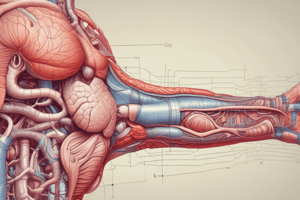Podcast
Questions and Answers
Which of the following is NOT an accessory organ of the digestive tract?
Which of the following is NOT an accessory organ of the digestive tract?
- Stomach (correct)
- Salivary glands
- Liver
- Gall bladder
What is the primary function of the large bowel?
What is the primary function of the large bowel?
- Absorption of water (correct)
- Absorption of minerals
- Absorption of nutrients
- Break down of food
What is the approximate length of the small bowel?
What is the approximate length of the small bowel?
- 12 inches
- 5-6 meters (correct)
- 2 meters
- 5 feet
Which part of the digestive tract is primarily responsible for mixing food with gastric juices?
Which part of the digestive tract is primarily responsible for mixing food with gastric juices?
Which of these surgical approaches is appropriate for a gall bladder procedure?
Which of these surgical approaches is appropriate for a gall bladder procedure?
What type of movement is responsible for passing food from the esophagus to the stomach?
What type of movement is responsible for passing food from the esophagus to the stomach?
Which structure connects the stomach to the small bowel?
Which structure connects the stomach to the small bowel?
What is the role of normal flora bacteria in the large bowel?
What is the role of normal flora bacteria in the large bowel?
A peptic ulcer is classified as which type of gastrointestinal disease?
A peptic ulcer is classified as which type of gastrointestinal disease?
Which of the following incisions is specifically associated with kidney disease surgery?
Which of the following incisions is specifically associated with kidney disease surgery?
Flashcards are hidden until you start studying
Study Notes
Digestive Tract Overview
- The digestive tract receives food and fluids, digests them, absorbs nutrients, and removes waste.
- Composed of several parts that work together in the digestion process.
Parts of the Digestive Tract
- Mouth: Contains lips, teeth, tongue, and salivary glands; food is chewed, mixed with saliva, and pushed to the esophagus.
- Esophagus: A 40 cm muscular tube that transports food to the stomach using peristaltic movements.
- Stomach: Hollow organ that mixes food with gastric juices and digestive enzymes for further breakdown.
- Duodenum: C-shaped, 12-inch long tube connecting stomach to small intestine; receives secretions from the pancreas and bile from the liver.
- Small Bowel: Approximately 5-6 meters long, consisting of jejunum and ileum; main function is the absorption of nutrients, vitamins, and minerals.
- Large Bowel: About 1.5 meters long, composed of caecum, ascending colon, transverse colon, descending colon, and sigmoid colon; absorbs water, produces solid waste, and hosts normal flora bacteria that synthesize vitamins.
- Rectum: Approximately 20 cm long; stores stool until it triggers a desire to pass it.
- Anal Canal: 3-4 cm long, surrounded by sphincters to control the passage of gas and stool.
Accessory Organs of the Digestive Tract
- Includes salivary glands, pancreas, liver, and gall bladder; aids in digestion but is not part of the digestive tract itself.
Diseases of the Gastrointestinal Tract
- Common conditions include:
- Aphthous ulcers
- Gastroesophageal reflux disease (GERD)
- Peptic ulcers
- Gallstones
- Pancreatitis
- Enteritis
- Irritable Bowel Syndrome (IBS)
- Ulcerative colitis and Crohn's disease
- Diverticulitis
- Acute appendicitis
- Hemorrhoids and fistulae
- Tumors
Surgical Approaches
- Describe how to reach diseased organs, e.g.:
- Head: Craniotomy, C shape incision
- Neck: Collar incision for thyroid procedures
- Chest: Antero-lateral and postero-lateral thoracotomy
- Abdomen: Midline incision for trauma, subcostal for gall bladder issues
- Gallbladder and appendix specific incisions include:
- Right and left para-median incision for gallstones
- Gridiron incision for appendectomy
- Supra-pubic incision for gall bladder
- Lumbar incision for kidney issues
- Pfannenstiel incision for cesarean sections
Key Facts
- Accessory Organs: Liver, stomach, salivary glands, gall bladder (liver, stomach are not accessory).
- Large Bowel Function: Primarily absorbs water (not nutrients or vitamins).
- Small Bowel Length: Approximately 5-6 meters (not 5 feet or other measurements).
Studying That Suits You
Use AI to generate personalized quizzes and flashcards to suit your learning preferences.




